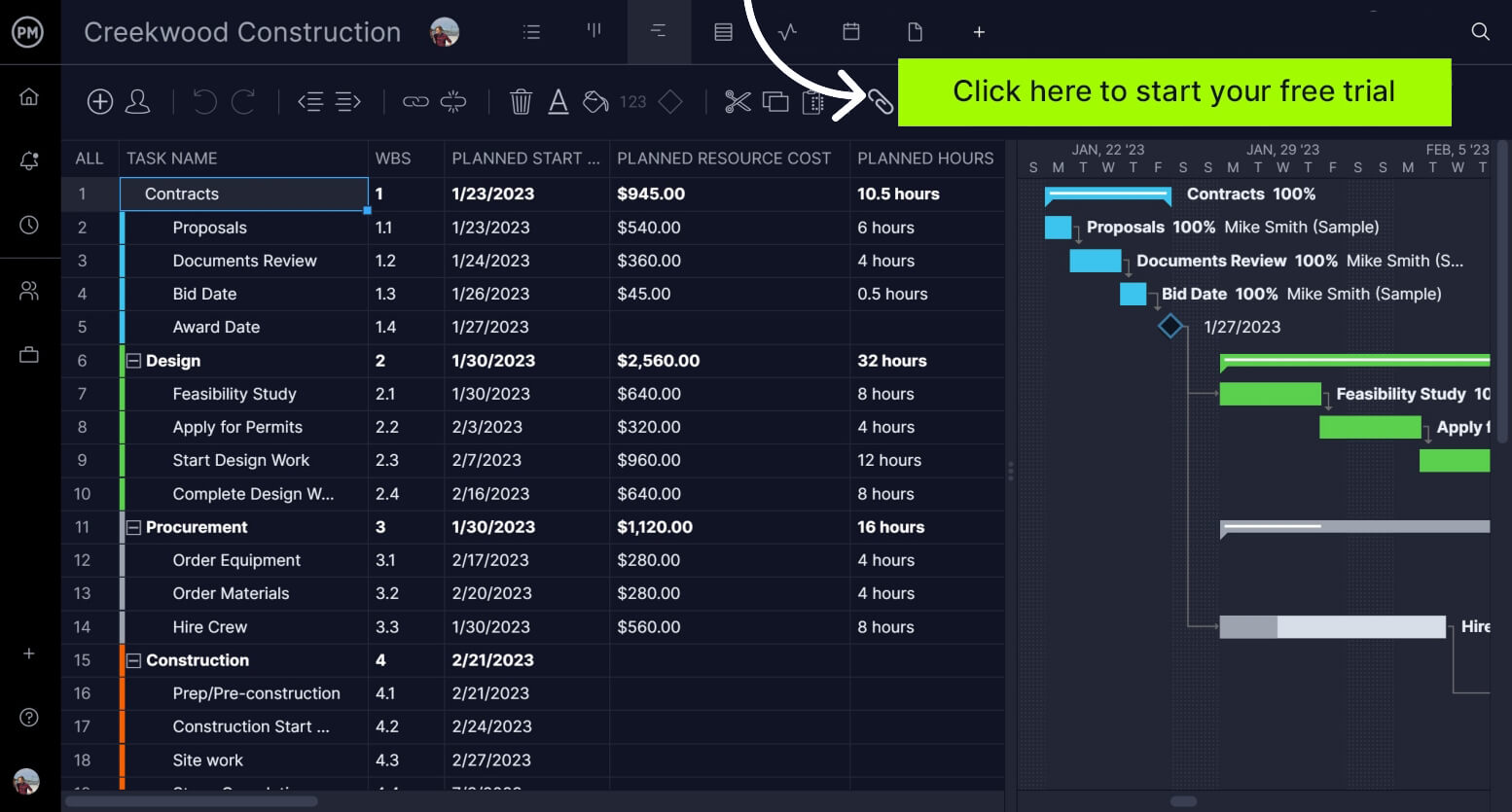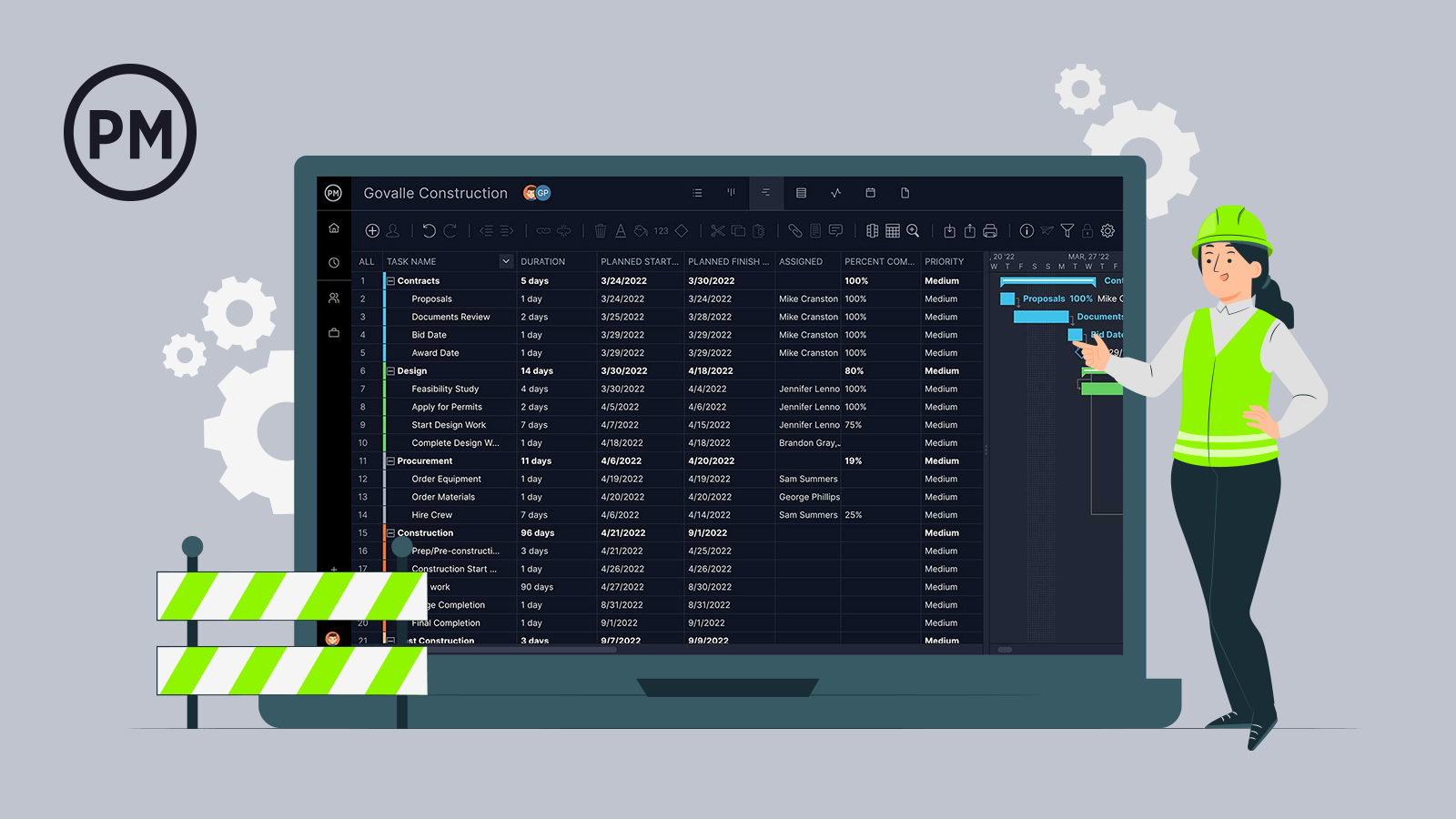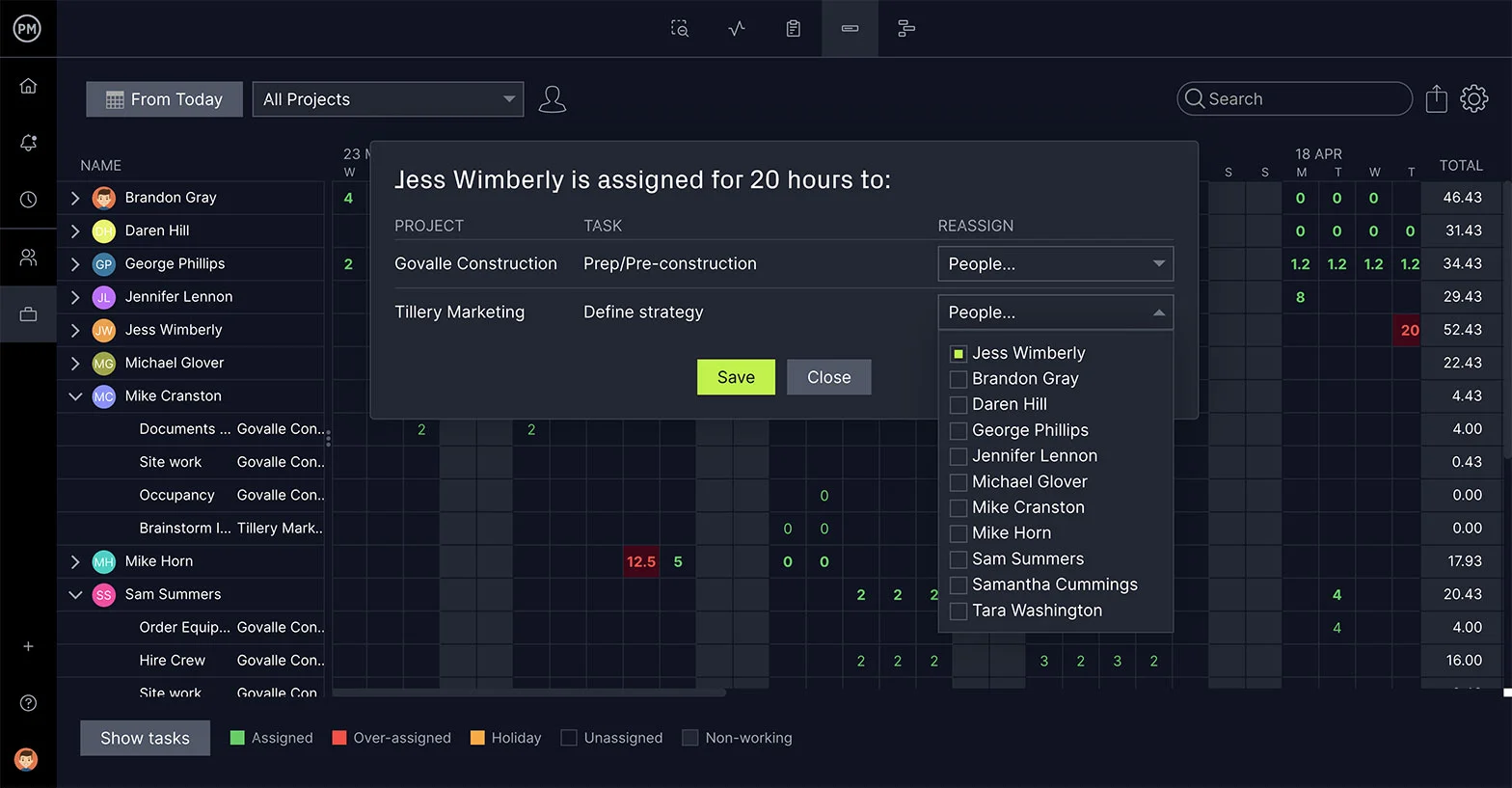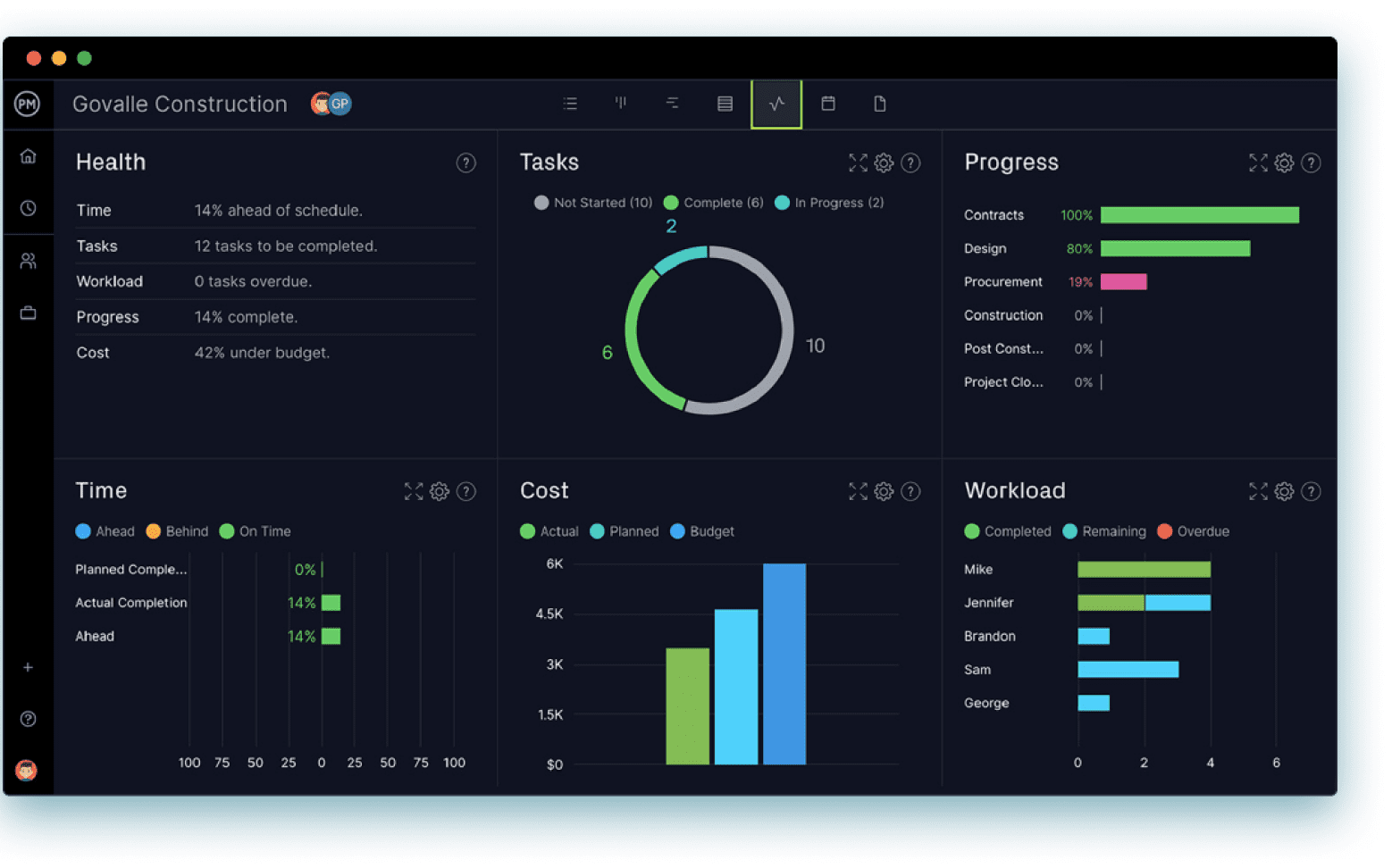When viewing construction, one commonly recognizes three sectors: residential, commercial and infrastructure. But each of these sectors can be further subdivided into categories. For example, commercial construction can be classified into three subcategories of retail, office, multifamily and industrial construction.
In this post, we’ll define industrial construction and how it differs from the rest of commercial construction. To further illustrate what industrial construction is, we’ll offer five examples and some of the challenges inherent in the construction sector. Finally, we’ll offer links to a few free construction project management templates to help manage industrial construction projects.
What Is Industrial Construction?
Industrial construction is the building of structures such as factories, power plants, warehouses and other highly specialized facilities. We’ll define those different examples of industrial construction shortly, but first, we need to explain how the design, installation and maintenance of mechanical and structural components for these facilities make up industrial construction.
The use of the word industrial is to separate this type of construction from other types of construction. That is, industrial construction refers to the building of structures for a business that manufactures goods. This is why industrial construction has special conveyance requirements, such as 24/7 shipping and receiving and accessibility to air and rail transport or major highways.
When building, industrial construction floor plans are very important because they need to promote smooth foot traffic and coordinate manufacturing and distribution. This is because industrial construction is made to be functional over stylish. It needs to support heavy equipment and must meet industry-specific requirements that require special permitting and occupancy requirements.
Being able to manage all these elements, including scheduling and the costs involved in industrial construction requires project management software. ProjectManager is award-winning construction project management software that has powerful Gantt charts that can schedule the project and make sure all its requirements are met. Our tool has unlimited file storage to keep all your project documentation in one place, links all four types of task dependencies to avoid costly delays and can filter for the critical path to identify essential tasks. When you set a schedule and cost baseline you can now track those elements in real time to manage project variance. Get started with ProjectManager today for free.

Industrial Construction vs. Commercial Construction
While industrial construction is a subset of the larger category of commercial construction, there are still differences between the two that need to be addressed. First, commercial construction is larger than industrial construction. It includes such buildings as offices, restaurants, hotels, stores, gyms and hospitals. Industrial construction is buildings that are involved in the production of goods, such as those types we’ve mentioned above and will detail later.
It’s not just the type of buildings, though, that separate industrial construction from commercial construction. They differ in five substantial ways. First, there’s the design. Industrial design is more about logistics and efficiency, while commercial design is more interested in attracting customers. Location is another difference. As we’ve mentioned, industrial construction is built in proximity to transportation and needs space to accommodate heavy machinery. Commercial construction is built where it can provide easy access to people, such as customers or patients.
The permitting process is also different. All construction sites must be permitted and follow state and federal regulations, but commercial construction meets local and zoning requirements, while industrial construction meets those requirements and more precise standards based on the work being done in the facility. Commercial construction is also relatively simple in terms of mechanical, electrical and plumbing (MEP), but industrial construction, which uses heavy machinery, is going to have a greater power load and therefore the MEP will usually require additional effort.

Get your free
Construction Schedule Template
Use this free Construction Schedule Template to manage your projects better.
Get the Template
5 Examples of Industrial Construction Projects
We’ve mentioned the various types of industrial construction projects, but only in passing. These are larger and more complex construction projects and deserve a bit more attention. Below we explore in greater detail some examples of the types of facilities built in industrial construction.
1. Warehouse and Distribution Centers
These structures are made to store and facilitate the transportation of goods and logistics management. Usually, a warehouse or distribution center is a one-story structure that can be anywhere from 5,000 square feet to hundreds of thousands of square feet. The ceilings tend to be at least 60 feet high as the interior has racking and storage systems housed inside. Other features can include loading docks, larger garage doors and parking lots big enough for semi-trailers that distribute the material within.
2. Manufacturing Facilities
Another type of industrial construction is manufacturing facilities. Here, rather than housing materials, the products the company sells are produced within these walls. Therefore, manufacturing facilities hold the equipment inventory used to make these products. That equipment is usually very heavy and expensive and the design of the facility must take that into account.
There will be increased foot traffic around this equipment and the facility will require a three-phase electrical supply to power that equipment throughout the day. There will also be heavy ductwork and high-capacity systems for ventilation and exhaust to remove any harmful chemicals and fumes released during the manufacturing process.
3. Power Plants
Another industrial construction project is the building of a power plant. This is a complex project that involves many components, all of which are industrial. There’s a boiler that heats water to produce steam, turbines to expand the steam to create mechanical energy and a generator that converts that mechanical energy from the turbine into electrical energy. This energy needs to be delivered outside of the building, which creates a complicated and long process.
4. Chemical Processing Facilities
Another complicated process is the construction of a chemical processing facility. Electrical engineers will have to calculate how much power is necessary for the plant and deal with the control systems. Mechanical engineers will focus on the construction of the structure and civil engineers are responsible for planning the transportation and water utility systems. Chemical engineers are also involved, primarily to deal with the operations of the plan, such as distillation columns, reactors and heat exchangers.
5. Mining Facilities
There are three main components to constructing a mining facility: good management, financing and a technically sound and economically feasible deposit. This is before the construction can even take place. Then there’s the building of the mine, construction of roads, rail, airstrips or ports to transport the mined deposit and the building of ancillary structures, such as the office, maintenance shop, warehouse, employee camp, kitchen and cafeteria, processing plant, waste storage and more.

Challenges of Industrial Construction
When involved in long-term and complicated capital projects, such as those in industrial construction, there are going to be a slew of challenges construction companies face. Below we detail some of those top concerns, but there are many more as you’d imagine.
Project Management
With industrial construction, there are challenges beyond the complexity of the work. As with any project, there’s the challenge of staying on budget and keeping to the schedule. These issues are more of a concern when dealing with such larger projects. If costs get out of hand or the schedule is unduly delayed, the project itself can become jeopardized.
Value Engineering
Value engineering is a systematic and organized approach to providing the necessary functions in a construction project at the lowest possible cost. This could be substituting materials and methods with less expensive options without sacrificing functionality.
Local Laws and Regulations
Obtaining building permits from the city, fire regulations, sewer/water regulations, and any possible land or environmental hazards is often a time-consuming if not arduous process. Each municipality has its own rules and regulations for pulling permits, which is an essential part of the building process. Builders have to understand this process and plan for it to meet their deadlines.
Worksite Safety
There are many things to consider when managing worksite safety, such as ventilation to clear harmful chemicals and ensure respiratory protection, heating, ventilation and air conditioning (HVAC) to avoid heat exhaustion, fall protection, personal protective equipment, etc. A job safety analysis helps industrial construction companies assess the different safety variables to be considered.
Specialized Workforce and Equipment
While building anything shares many of the same types of project resources such as workers and equipment, industrial construction is unique. It requires specialized skills, often of a highly technical nature. Innovative technology and equipment range from transportation to material handling and earthmoving machines.
Contractor and Subcontractor Management
Having a lot of different specialized professionals on the job site working together is going to involve supervision to ensure that they don’t get in each other’s way. An industrial construction job site will also have to make sure that everyone working is doing so in such a way that their specific jobs are done on time and within budget.
Renovation and Revamping
Renovating or revamping an existing industrial site is often just as challenging as starting from scratch. It’s not always as expensive and time-consuming as one would expect. The age of the structure has to be taken into account
Fire Protection Systems
To protect the finished structure, fire protection systems will need to be installed. These suppression systems help to prevent fires from spreading and reduce property damage with the use of foams, dry chemicals and water mists, among other techniques.
Construction Project Management Templates
Having all the responsibilities and challenges inherent in industrial construction requires the right tools to manage all that work. One way to go is by using construction project management templates. ProjectManager has dozens of free project management templates for Excel and Word that you can download to help you get started. Here are just a few.
Construction Estimate Template
The first step to an accurate construction budget is an accurate estimate. Our free construction estimate template for Excel helps you list all your labor and material costs as well as being able to forecast your profit margin.
Construction Schedule Template
Industrial construction has a deadline like any project. Using our free construction schedule template allows you to organize your tasks, set milestones, link dependencies and much more. You’ll also be able to incorporate resources and costs.
Construction Daily Report Template
During every day of the project’s execution, a report needs to be filed to list what’s been done, what needs to be done and much more. All those items are collected on our free construction daily report template for Excel.
How ProjectManager Helps With Industrial Construction
While templates can help you set up a project, once you get into the planning stage and move into execution and control you’re going to need more than they can provide. That’s why project management software is so important. ProjectManager is award-winning construction project management software that helps you plan, manage and track your industrial construction projects in real time. Once you’ve scheduled your project on Gantt charts, you can then track progress and costs to stay on schedule and not go over your budget.
Monitor Progress and Performance With Real-Time Dashboards
Whenever you need to get a high-level overview of your project just toggle over to the live dashboards. It automatically collects real-time data and displays it in easy-to-read graphs and charts that track project metrics such as time, cost, workload and more. Unlike lightweight construction project management tools, you don’t have to spend a lot of time setting up our dashboard. It’s ready when you are.
 Manage Labor Costs With Secure Timesheets
Manage Labor Costs With Secure Timesheets
Keeping track of subcontractors and the construction crew on the work site is essential to bringing the project within budget. Our secure timesheets streamline the payroll process, but also give general contractors insight into how long each team member is taking on their tasks, how close to completion they are and the amount of money being spent for them to get their work done.

Our resource management features help you balance workload to keep teams working at capacity and staying productive. We also have reporting tools to get more details on project status, variance, workload, timesheets and much more. Risk management tools help you identify and track issues in your project and task management features have multiple project tools that allow teams to work how they want.
Related Construction Project Management Content
- 10 Best Construction Project Management Software
- 18 Construction Methods and Techniques
- 10 Types of Construction Projects with Examples
- Critical Path Method (CPM) in Construction: A Quick Guide
- 8 Free Construction Forms for Excel and Word
- Construction Contingency: A Quick Guide
- Gestión de Construcción Industrial: Principios Básicos y Características
- Industriebau: Beispiele für Industrieprojekte
ProjectManager is online construction project management software that connects teams whether they’re in the office, on the job site or anywhere in between. They can share files, comment at the task level and get notified by email or with in-app alerts whenever there’s a change to keep everyone on the same page. Get started with ProjectManager today for free.


